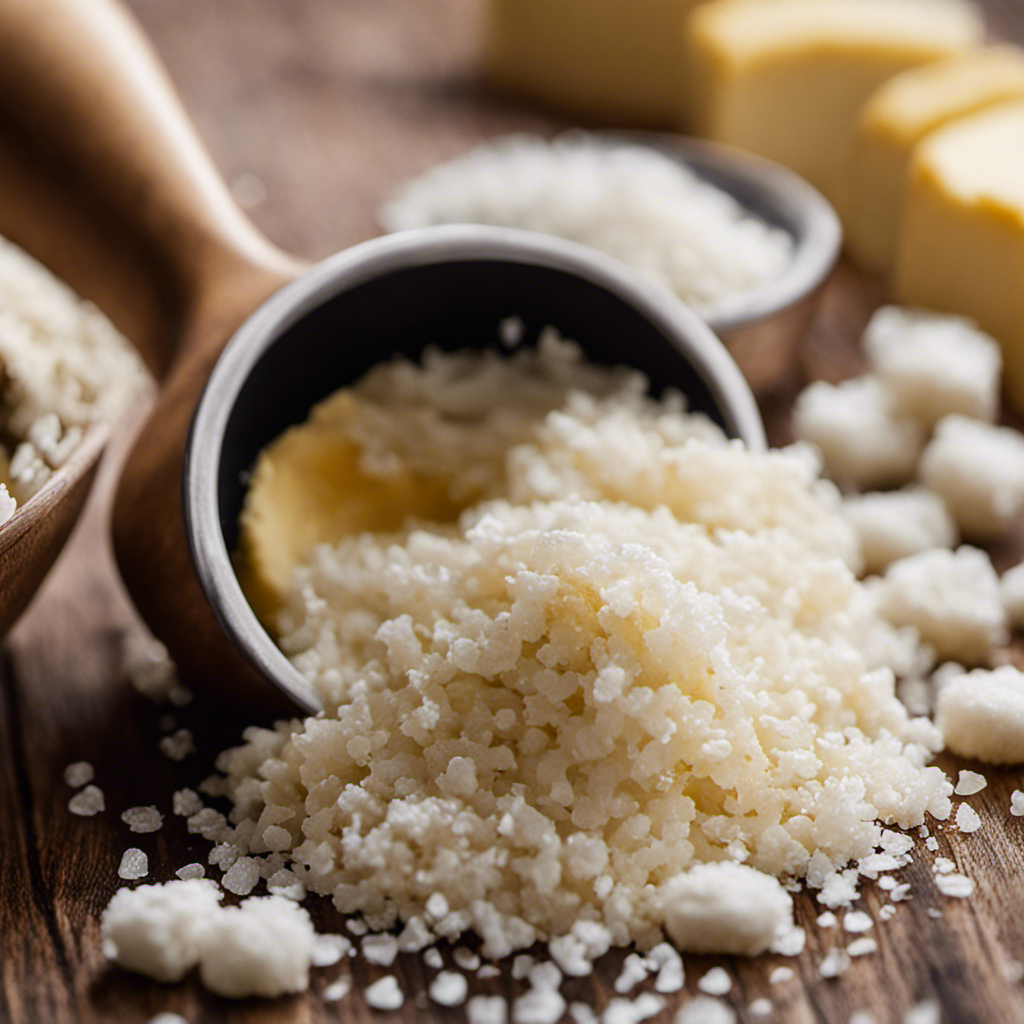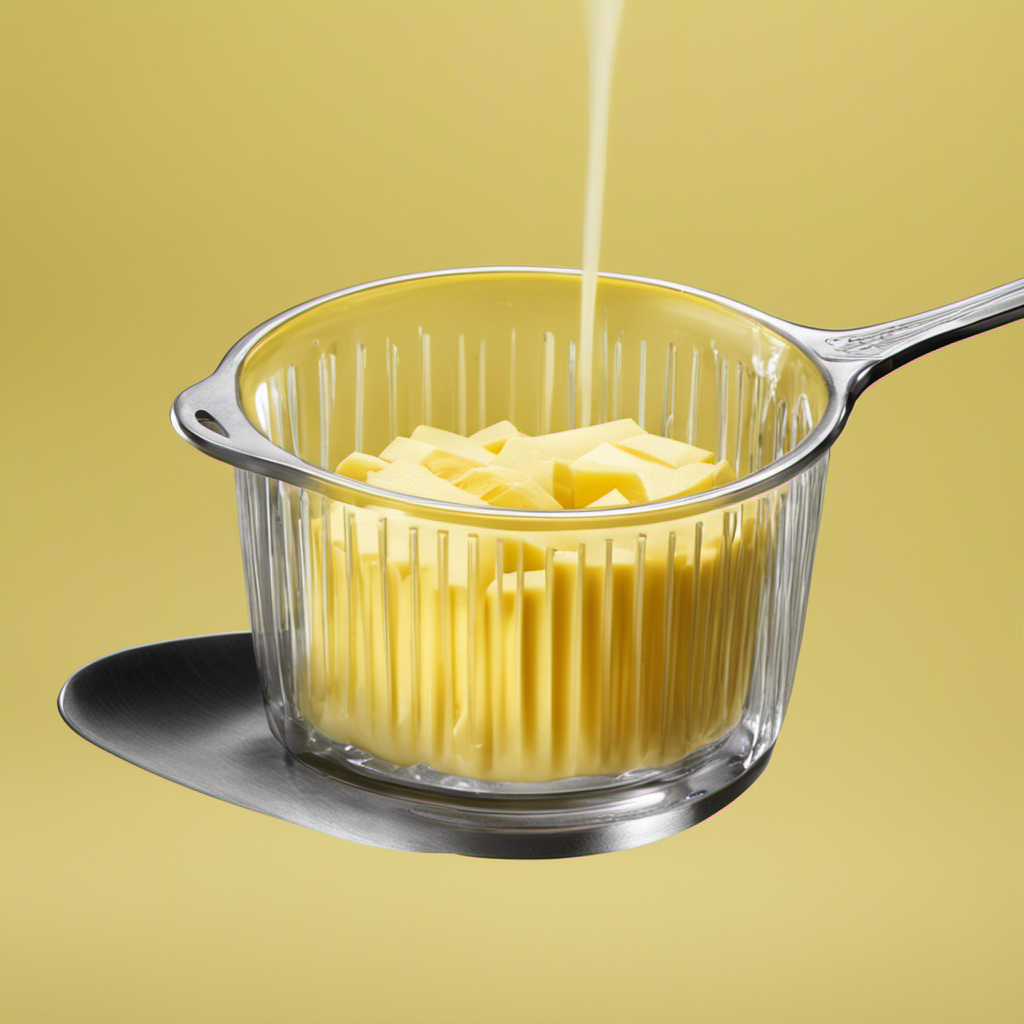I’ve always been curious about the right amount of salt to put in my homemade butter. Finding the perfect equilibrium is crucial because if there’s not enough, the butter ends up tasteless, but if you add too much, it can dominate and mask the butter’s natural taste.
In this article, we’ll dive into the science behind salt in homemade butter and explore the factors to consider when adding it. We’ll also discuss the recommended salt-to-butter ratio for a flavorful result and share tips for incorporating salt properly.
Let’s uncover the secrets to perfectly salted homemade butter!
Key Takeaways
- Salt enhances the natural taste and adds depth to the flavor profile of homemade butter.
- Finding the right balance of salt is crucial for achieving the desired taste and texture of homemade butter.
- Excessive sodium intake can lead to health issues like high blood pressure, heart disease, and stroke, so it’s important to be mindful of the amount of salt consumed.
- Experimenting with seasoning options and salt alternatives can help customize the flavor profile of homemade butter and provide health benefits.
Understanding the Importance of Salt in Homemade Butter
You may be wondering why adding salt is important when making homemade butter. Well, let me explain the importance of seasoning and the benefits of using salt in this process.
Salt acts as a flavor enhancer, bringing out the natural taste of the butter and adding depth to its flavor profile. It also helps to balance the overall taste by reducing any excessive sweetness or blandness.
Moreover, salt acts as a preservative, inhibiting the growth of bacteria and prolonging the shelf life of the butter. Additionally, salt helps in the formation of a stable emulsion, ensuring a smooth and creamy texture.
Factors to Consider When Adding Salt to Homemade Butter
When it comes to adding salt to homemade butter, two important factors to consider are salt concentration and taste.
Salt concentration refers to the amount of salt added to the butter, which can greatly influence the overall flavor.
Additionally, it is crucial to be mindful of the health implications of salt, as excessive consumption can lead to various health issues such as high blood pressure and cardiovascular disease.
Hence, finding the right balance between salt concentration and taste is essential for both flavor and health considerations.
Salt Concentration and Taste
The salt concentration in homemade butter affects its taste. Salt plays a crucial role in enhancing the flavor of butter by reducing bitterness and enhancing sweetness. The level of salt concentration directly influences our taste perception.
Scientific studies have shown that the addition of salt to butter can significantly impact its taste profile. When the salt concentration is too low, the butter may taste bland and lacking in flavor. On the other hand, if the salt concentration is too high, the butter can become overly salty, overpowering the natural flavors. Therefore, finding the right balance is essential to achieve the desired taste.
Now, let’s explore the health implications of salt and how it can affect our well-being.
Health Implications of Salt
To maintain a healthy lifestyle, it’s important to be mindful of the amount of salt you consume. Excessive sodium intake has been linked to various health issues, including high blood pressure, heart disease, and stroke. However, it’s worth noting that salt also has its health benefits when consumed in moderation. It plays a crucial role in maintaining fluid balance, nerve function, and muscle contractions.
Here is a table summarizing the health implications of salt:
| Health Benefits of Salt | Sodium Intake |
|---|---|
| Fluid balance | Moderate |
| Nerve function | Moderate |
| Muscle contractions | Moderate |
As you can see, consuming salt in appropriate amounts is important for overall health. In the next section, we will discuss the recommended salt-to-butter ratio for flavorful homemade butter.
Recommended Salt-to-Butter Ratio for Flavorful Homemade Butter
When it comes to achieving the optimal saltiness level in homemade butter, it is important to consider the recommended salt-to-butter ratio for a flavorful taste.
Experimenting with different seasoning options can also be a great way to customize the flavor profile of your homemade butter.
Additionally, for those looking for alternatives to salt, there are various options available that can still enhance the taste and richness of butter.
Optimal Saltiness Level
For the optimal saltiness level in your homemade butter, you’ll want to taste it and adjust accordingly.
The saltiness level of butter varies depending on personal preference, but there are some guidelines to consider. Too little salt can make the butter taste bland, while too much can overpower the natural flavors.
It is recommended to start with a small amount of salt and gradually add more until the desired taste is achieved. Conducting seasoning experiments can be helpful in finding the perfect balance.
Try adding different amounts of salt to small portions of butter and taste each one to determine the ideal saltiness level. This will allow you to fine-tune the seasoning according to your taste preferences.
Experimenting with seasoning is key to achieving the perfect homemade butter.
Experimenting With Seasoning
Adjusting the seasoning in your recipe is crucial to finding the ideal taste for your homemade butter. Experimenting with different flavors allows you to discover the perfect balance that suits your palate. Here are some factors to consider when seasoning your butter:
- The type of salt used: Whether it’s kosher salt, sea salt, or flavored salts, each brings a unique taste and texture to your butter.
- The amount of salt: Start with a small amount and gradually increase it until you reach your desired level of saltiness.
- Other herbs and spices: Adding herbs like thyme or spices like smoked paprika can elevate the flavor profile of your butter.
- Sweet and savory combinations: Try incorporating ingredients like honey, garlic, or lemon zest to create a versatile butter that works well in both sweet and savory dishes.
- Texture: Experimenting with different textures, such as coarse or fine salt, can enhance the overall experience of your butter.
By experimenting with these factors, you can find the perfect balance of flavors for your homemade butter.
Now, let’s explore some salt alternatives for those looking for different seasoning options.
Salt Alternatives for Butter
Using salt alternatives can be a great way to add a unique flavor to your homemade butter. Not only do they provide a variety of tastes, but they also offer several health benefits. By reducing your salt intake, you can lower your risk of high blood pressure, heart disease, and stroke. Incorporating different salt alternatives into your butter can enhance its taste without sacrificing your health. Here is a table showcasing three popular salt alternatives for butter:
| Salt Alternative | Flavor Profile | Health Benefits |
|---|---|---|
| Sea Salt | Salty, slightly sweet | Rich in minerals like iodine |
| Herbs and Spices | Savory, aromatic | Antioxidant properties |
| Citrus Zest | Tangy, refreshing | High in vitamin C |
Experimenting with these alternatives can add depth and complexity to your homemade butter while promoting a healthier lifestyle. So why not try something new and reduce your salt intake at the same time?
Adjusting Salt Levels for Personal Taste Preferences
To customize the taste of your homemade butter, you can simply adjust the salt levels according to your personal preferences. Salt plays a crucial role in enhancing the flavor of butter, and by adjusting the amount, you can achieve the perfect balance of saltiness.
When it comes to adjusting saltiness in homemade butter, here are some factors to consider:
- Start with a small amount of salt and gradually increase to taste.
- Experiment with different types of salt, such as sea salt or Himalayan salt, to explore different flavor profiles.
- Consider the salt content of any additional ingredients you may be using, such as herbs or spices.
- Take into account the intended use of the butter – more salt may be desired for savory dishes, while less may be preferred for sweet dishes.
- Remember that personal taste preferences vary, so don’t be afraid to customize the salt levels to your liking.
By understanding the art of adjusting saltiness, you can create homemade butter that perfectly suits your taste buds.
Now, let’s explore some tips for properly incorporating salt into homemade butter.
Tips for Properly Incorporating Salt Into Homemade Butter
When it comes to incorporating salt into your homemade butter, you’ll want to make sure you mix it thoroughly to ensure even distribution of flavor. Properly incorporating salt into your butter is crucial for achieving the desired taste. To help you understand the importance of proper mixing and storage, I have created a table below that outlines some common troubleshooting issues and their solutions.
| Troubleshooting Issue | Solution |
|---|---|
| Uneven salt distribution | Thoroughly mix the salt into the butter, ensuring it is evenly dispersed. |
| Excessive saltiness | Gradually add salt, tasting as you go, to avoid over-salting. Consider diluting with unsalted butter. |
| Salt clumps in butter | Allow the butter to soften slightly before adding the salt. Alternatively, use fine-grained salt. |
To ensure the longevity of your homemade butter, proper storage is essential. Store it in an airtight container in the refrigerator to prevent spoilage and maintain freshness. Troubleshooting issues can arise, but with these tips, you’ll be able to achieve perfectly salted homemade butter every time.
Common Mistakes to Avoid When Salting Homemade Butter
When salting homemade butter, it’s important to be aware of common mistakes that can impact the final product and have health implications. Here are five common mistakes to avoid:
-
Adding too much salt: Over-salting can lead to an unpleasant taste and health issues such as high blood pressure.
-
Not tasting the butter before salting: It’s crucial to taste the butter and adjust the seasoning accordingly, as the saltiness can vary depending on the cream used.
-
Adding salt too early: Salt draws out moisture, so adding it too early can result in a watery butter.
-
Using iodized salt: Iodized salt can affect the texture and flavor of the butter, so it’s best to use non-iodized salt.
-
Not evenly distributing the salt: Failing to evenly distribute the salt can result in pockets of saltiness or blandness in the butter.
Frequently Asked Questions
Can I Use Different Types of Salt for Homemade Butter?
Yes, you can use different types of salt for homemade butter. Experiment with sea salt, kosher salt, or flavored salts to enhance the flavor. However, if you prefer a salt-free option, you can enhance the butter’s taste with herbs or spices.
How Long Does Homemade Butter With Salt Last in the Fridge?
To properly store homemade butter with salt and prevent it from spoiling quickly, it is important to refrigerate it in an airtight container. The butter can last for about 2-3 weeks in the fridge.
Can I Use Unsalted Butter and Add Salt Later?
Yes, you can use unsalted butter and add salt later. This allows for more control over the saltiness of the butter. For example, you can start with unsalted butter and add a pinch of salt to taste.
What Are Some Alternative Seasonings I Can Use Instead of Salt in Homemade Butter?
I can enhance the flavor of homemade butter by using alternative seasonings instead of salt. These seasonings can include herbs like rosemary or thyme, spices like garlic or paprika, or even citrus zest for a refreshing twist.
Is It Possible to Make Unsalted Butter Taste Salty Without Adding Salt?
To enhance the flavor of unsalted butter and balance the saltiness in homemade butter, you can try incorporating other seasonings like herbs, spices, or even citrus zest. Experiment with different combinations to find your preferred taste.
Conclusion
In conclusion, understanding the importance of salt in homemade butter is crucial for achieving the perfect flavor. By considering factors such as personal taste preferences and the recommended salt-to-butter ratio, one can create a delicious and flavorful butter.
Incorporating salt properly and avoiding common mistakes will ensure the best results. So, next time you make homemade butter, don’t forget to add just the right amount of salt to enhance its taste and make it a truly delightful experience. Your taste buds will thank you!









